 It’s
the wee hours of the morning on a day in 1946 and an exhausted 32-year-old Dr. Ernest Ceriani, pauses with a
cup of coffee and a cigarette in the kitchen of the small hospital
in Kremmling, Colorado, a town of 1,000 people 115 miles west of
Denver, after an operation which lasted until 2:00 A.M.. The nurses
on duty beg him to take a rest, but because they’re aware that as a
country doctor he cannot, they keep fresh coffee simmering for him
at all times. Photojournalist W. Eugene Smith followed Dr. Ceriani
through his daily rounds and captured him doing his work as part of
one of the most poignant and in-depth photo essays on the vanishing
general practitioner, “The Country Doctor,” for LIFE Magazine in
1948. Ceriani serves as physician, surgeon, pediatrician,
psychiatrist, obstetrician, dentist, oculist and laboratory
technician to people in a 400-square-mile area around the town. To
them, he’s a lifesaver.
It’s
the wee hours of the morning on a day in 1946 and an exhausted 32-year-old Dr. Ernest Ceriani, pauses with a
cup of coffee and a cigarette in the kitchen of the small hospital
in Kremmling, Colorado, a town of 1,000 people 115 miles west of
Denver, after an operation which lasted until 2:00 A.M.. The nurses
on duty beg him to take a rest, but because they’re aware that as a
country doctor he cannot, they keep fresh coffee simmering for him
at all times. Photojournalist W. Eugene Smith followed Dr. Ceriani
through his daily rounds and captured him doing his work as part of
one of the most poignant and in-depth photo essays on the vanishing
general practitioner, “The Country Doctor,” for LIFE Magazine in
1948. Ceriani serves as physician, surgeon, pediatrician,
psychiatrist, obstetrician, dentist, oculist and laboratory
technician to people in a 400-square-mile area around the town. To
them, he’s a lifesaver.
Since Smith shot his photo essay for LIFE, the practice of medicine
has changed a lot. Today, heart transplants and bypasses are common,
and doctors cure more patients of cancer than ever before. But
managed health care, known as HMOs, rule today’s
medicine---impersonal procedures, bureaucracy, high malpractice
premiums, and exhausted physicians. Patients are no longer people
but numbers and percentages. And throughout the day, the clock ticks
away.
And while country doctors like Ceriani still exist, they’re few and
far between. The day of the house call is long gone. This can be
attributed, in part, to the attitude of medical schools which
present specialization as glamorous and general practice as a
thankless chore to their students. Also, health clinics, both
independently owned and in association with drugstore chains, have
begun to spring up all over.
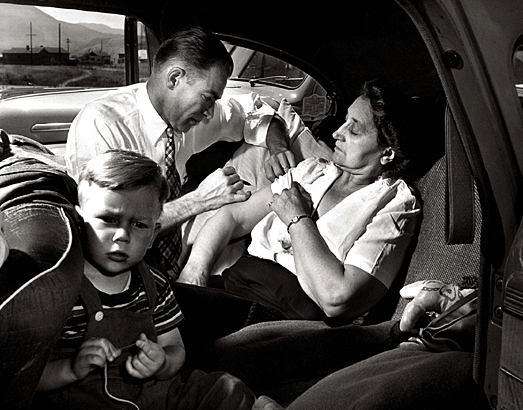
General practitioners, especially country doctors, make far less for
covering a dozen fields than other doctors specializing in one. In
1947, when Smith took his photos, GPs earned less then $10,000 a
year. And while they earn more today, the fate of thousands of
communities like Kremmling, in dire need of general practitioners,
depends on whether 22,000 medical students, who each year choose
between specialization and general practice, also think it’s enough.
But a country doctor’s time is rarely his or her own. The needs of
patients come first, many times in the middle of the night. The
union of a general practitioner and his or her patients is like a
marriage–affectionate, difficult and long-lasting–a type of
relationship that goes far beyond the meager pay but offers far
greater rewards.
After an exhausting operation in the pre-dawn hours, Dr. Ceriani
begins work soon after 8:00 A.M. and will continue far into the
night. He serves as physician, surgeon, obstetrician, pediatrician,
psychiatrist, dentist, oculist and laboratory technician. Like most
rural GPs he has no vacation and few days off, although unlike them
he has a small hospital in which to work.
A tourist guide and his baby are the doctor’s first office call of
the day. They have come to Kremmling from an outlying ranch.
Ceriani's patients are of all ages and income groups and come from
areas without doctors as far as 50 miles away.
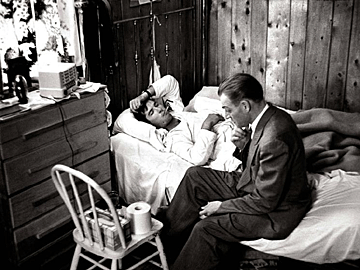 After
taking care of the baby, Ceriani is off on a home call at 8:30 A.M..
He prefers to treat patients during office hours at the hospital,
but because a local printer had a fever and symptoms of influenza
Ceriani thought it would be unwise for him to get up and make the
trip.
After
taking care of the baby, Ceriani is off on a home call at 8:30 A.M..
He prefers to treat patients during office hours at the hospital,
but because a local printer had a fever and symptoms of influenza
Ceriani thought it would be unwise for him to get up and make the
trip.
Back at the office, he explains an X-RAY, which Ceriani developed
himself, to a rancher. In addition to the X-ray machine, the
hospital contains about $10,000 worth of equipment, including a
$1,500 autoclave and an oxygen tent.
A minor emergency disrupts Ceriani's office routine. A 60-year-old
tourist, suffering from a heart disturbance aggravated by a trip
through an 11,000-foot pass in the Rockies, came to the hospital to
get an injection of morphine.
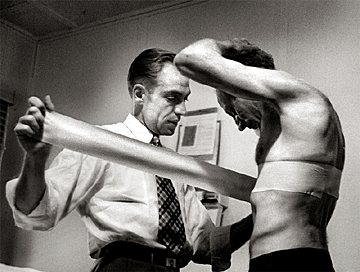 Next
he binds a man’s ribs, injured when a horse rolled over him. Many of
his hardy patients walk in with injuries which would make city
dwellers call at once for an ambulance.
Next
he binds a man’s ribs, injured when a horse rolled over him. Many of
his hardy patients walk in with injuries which would make city
dwellers call at once for an ambulance.
Another home call, several hours into his day, takes Ceriani to the
home of a feverish 4-year-old suffering from acute tonsillitis.
Although a large proportion of his patients are children, Dr.
Ceriani is still inexperienced in pediatrics and studies it whenever
he has an opportunity.
That afternoon, the young doctor attempts to take a much needed
three-hour break to go fishing. His moments of relaxation are rare
and brief. He asks two employees of the Denver and Rio Grande to
take him out on a railroad gasoline car to Gore Canyon. There he
fished alone in the rapids of the Colorado, working expertly over
the white water for almost 30 minutes. Suddenly he saw the car
coming back up the canyon far ahead of time and automatically began
to dismantle his fishing rod. Ceriani had no feeling of resentment
at the quick end of his excursion. He just stood still waiting for
the car to reach him, wondering what had happened and hoping that it
wasn’t something serious. When the car arrived Chancy Van Pelt, the
town Marshal, hopped off and said, "Little girl at the Wheatly ranch
got kicked in the head by a horse. Can you come now?"
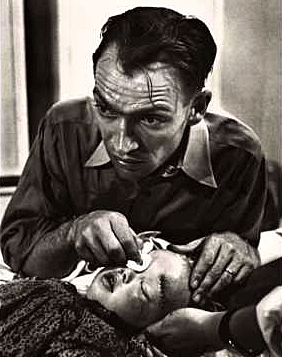 Lee
Marie Wheatly, aged 2˝, was already in the hospital when Ceriani
arrived. While her parents watched, he looked for signs of a skull
fracture, stitched up a great gash in her forehead and saw that her
left eyeball had collapsed. Then he advised the Wheatlys to take
their child to a specialist in Denver for consultation on removal of
the eye.
Lee
Marie Wheatly, aged 2˝, was already in the hospital when Ceriani
arrived. While her parents watched, he looked for signs of a skull
fracture, stitched up a great gash in her forehead and saw that her
left eyeball had collapsed. Then he advised the Wheatlys to take
their child to a specialist in Denver for consultation on removal of
the eye.
Having done his best for the child, Ceriani is worn out and tense as
he completes the emergency treatment. He has stitched the wound in
her forehead so that she will have only a slight scar, but already
knows that nothing can be done to save her eye and tries to think of
a way to soften the news for her parents.
After they left, Ceriani was haggard and profoundly tired. He didn’t
remember that he had been fishing at all until, on his way out of
the emergency room, he saw his rod and reel lying in the corner
where he had thrown them.
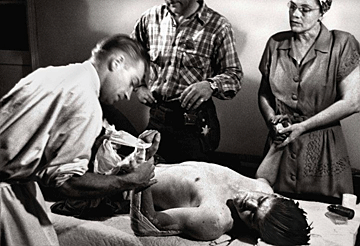 Pausing
to have another cup of coffee, Ceriani gets a call telling him that
a young man named Robert Wiggs had been thrown from a horse and
injured at a rodeo in nearby Granby. When the young man’s friends
arrived with him, the doctor helped carry him into the hospital.
Wiggs had a dislocated left elbow. Ceriani X-rayed the arm. He gave
Wiggs some ether and pulled on his arm to bring the elbow joint back
into place. Then Ceriani applied a cast while the young man murmurs,
“Don’t tell my mother,” not realizing that his mother was holding
his hand.
Pausing
to have another cup of coffee, Ceriani gets a call telling him that
a young man named Robert Wiggs had been thrown from a horse and
injured at a rodeo in nearby Granby. When the young man’s friends
arrived with him, the doctor helped carry him into the hospital.
Wiggs had a dislocated left elbow. Ceriani X-rayed the arm. He gave
Wiggs some ether and pulled on his arm to bring the elbow joint back
into place. Then Ceriani applied a cast while the young man murmurs,
“Don’t tell my mother,” not realizing that his mother was holding
his hand.
A few minutes before midnight the people in Joe Jesmer's house
called Dr. Ceriani to tell him that Joe was very sick. Ceriani put
on a cloth jacket, went over there quickly and found 82-year-old Joe
dying after a heart attack. He was still conscious, but in his pain
and bewilderment he felt that he was somehow trapped and needed
rescuing. He continually said, "Please, please get me out of here."
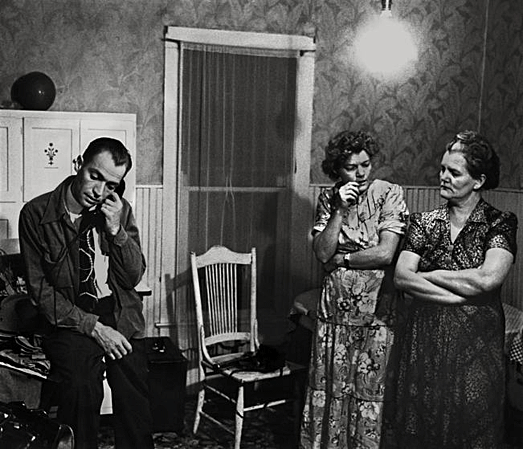
In the parlor Ceriani tucks a blanket around the dying man before
taking him out into the night. In the kitchen, while the women
whisper, Ceriani telephones the priest to tell him that the old man
will not live through the night Ceriani and Chancy Van Pelt got Joe
onto a stretcher (left), while Helen Watson, a roomer in Joe's house
stood watching quietly and without tears. Ceriani called the priest,
asking him to come to the hospital. Chancy and he carried Joe out to
the ambulance and drove off. There was nothing Ceriani could do
except make Joe comfortable and watch him die. At about 2:30 it
happened. He left the hospital then and went home, finding his wife
asleep and his own house as quiet as all the rest in town. At
Midnight Joe Jesmer's womenfolk stand silently around the door to
see him taken away.
And so Dr. Ceriani’s day begins all over again, and he hasn’t even
been home to see his wife.
